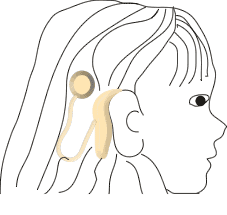 Who's
Listening?
Who's
Listening?
A Child With Hearing Loss in a Regular Education Classroom
Technology
Discussion and Web Safari Links
Technology
Hearing aid technology has come a long way since the original hearing horns.
We now have many choices for children with hearing losses. The primary choices involve hearing aids, assistive listening devices and cochlear implants. None of these will help a child to hear "normally."
Hearing
Aids
A hearing aid is fitted to a specific child to amplify the sounds. While
it cannot replace the letter sounds a child cannot hear because of their
hearing loss it will amplify the other sounds so it is easier for the
child to fill in the blanks.
Many of the children will have FM systems. The teacher wears a microphone that transmits their voice over an FM frequency directly to the child's hearing aid. This allows the child to hear the teacher's voice without disruptive background noise which makes it more difficult to hear and understand speech.
Assistive
Listening Devices
An assistive listening device is used to help overcome background noises.
Other than the FM systems worn by each individual child the most common
in the classroom is a sound field system. The teacher wears a microphone
which transmits their voice to speakers in the classroom. The voice is
amplified above the classroom noise and can be heard clearly any where
in the room. These are generally used with children with a mild to moderate
loss who frequently do not wear hearing aids.
This system benefits the teacher in that voice fatigue is reduced because they no longer have to raise their voice to be heard. Studies have also shown that children with auditory processing problems, auditory attention defecits and auditory learning disabilities along with the general student population learn better as well.
C-Print
Some students will come to class aided by a C-Print captionist. C-Pring
is a computer assisted speech to print system.
The C-Print captionist types the teacher's lecture along with student comments into a laptop computer. The student is able to read what is said on a second laptop or a tv monitor (usually used when more than one student is in the class.) This allows the student to read all of a lectufe or catch what the ste student missed through lipreading and/or listening. This method provides a second advantage. It is also possible to print out the lecture for further review.
Tips for C-Print
Repeat student comments if not loud enough
Limit class discussion to one student at a time-the captionist can only
type one person speaking at a time.
Cochlear
Implants
 A
cochlear implant is surgically implanted and transmits electrical stimulation
within the inner ear. It does not cure the hearing loss. It does provide
partial hearing to a profoundly deaf person.
A
cochlear implant is surgically implanted and transmits electrical stimulation
within the inner ear. It does not cure the hearing loss. It does provide
partial hearing to a profoundly deaf person.
An external microphone is attached to the implant (usually at ear level) and the child wears a small unit (about the size of a walkman) that converts the sound to electrical signals that are transmitted to the implant.
The benefit of a Cochlear implant depends on the age when implanted, the age the hearing loss occurred, the quality of training after the implant and the condition of the cochlea itself.
There is not instant "hearing" after an implant. It takes several years of therapy and hard work to fully benefit from an implant. The more recent the implant the less a child will understand with auditory only support. some children may have a sign language interpreter when in a regular ed classroom until they can function independently.
Teacher Responsibilities
- Check to make sure child is wearing hearing aids when arriving at school.
- Possibly hold spare batteries in desk
- Wear microphone and use during all instruction times.
- Charge batteries nightly for FM/Sound Field system and replace battery as needed.
- Report problems to hearing support teacher (or person responsible.)
Additional Resources
http://www.utdallas.edu/~loizou/cimplants/children/
http://www.listen-up.org/htm/backto.htm
http://www.beginningssvcs.com/assistive_technology/hearing_aids.htm
http://www.beginningssvcs.com/assistive_technology/about_alds.htm
http://www.beginningssvcs.com/assistive_technology/cochlear_implants.htm
http://netac.rit.edu/c-print.html This C-Print site was under construction as of August 2002.
copyright 2002
Cheryl Briggs
last revised August, 2002
This site is best viewed with Internet
Explorer 5.0 at 800 X 600 resolution
